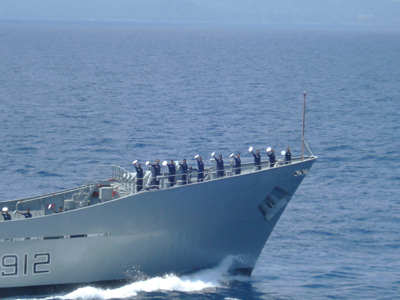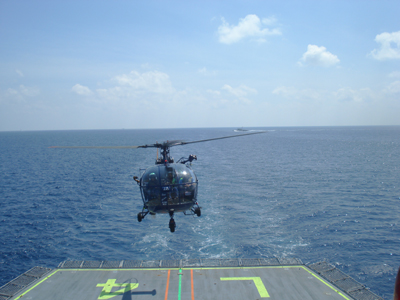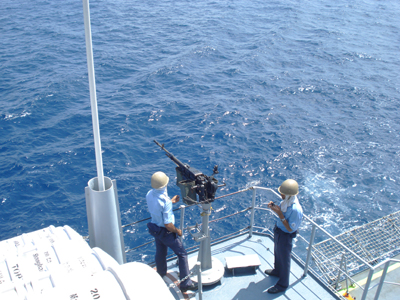|
 Designated
Milan (meeting of minds or coming together in
Hindi), the biennial exercise was a reflection
of the growing influence of both its maritime
power and goodwill, built upon its periodic assistance
to neighbouring countries in disaster relief,
particularly in the 2004 tsunami. This was the
7th edition of the exercise, held Feb 4-8 with
its command centre at Port Blair. Designated
Milan (meeting of minds or coming together in
Hindi), the biennial exercise was a reflection
of the growing influence of both its maritime
power and goodwill, built upon its periodic assistance
to neighbouring countries in disaster relief,
particularly in the 2004 tsunami. This was the
7th edition of the exercise, held Feb 4-8 with
its command centre at Port Blair.
Appropriately, it began with an international
seminar on ‘Navies in Humanitarian Assistance
and Disaster Relief.’
The exercise was also a manifestation of the
Indian Navy’s “Look East” policy,
to engage with the countries in the Indian Ocean
Region and to enhance the security of the sea
lines of communication, pivotal for the energy
supplies on India’s east and west.
Andaman and Nicobar islands are significant for
India from strategic point of view for increasing
surveillance in the nearby Strait and Bay of Bengal.
While China is believed to have monitored the
seventh edition of the multi-nation exercise,
the Indian Navy sought to play down Beijing’s
anxiety saying it was not aimed at creating an
anti-China security bloc. Chinese concerns are
believed to have been fed by the participation
of Philippines, Vietnam and Malaysia, who are
competing with China to grab their share of oil
and natural gas reserves in the Spratly region.
 Earlier,
Beijing had accused India of trying to create
a security bloc against it when the multi-nation
Malabar exercise was held in the Bay of Bengal
in 2007. China raised fears that a security quadrilateral
consisting of the US, India, Australia and Japan,
all of which had taken part in the Malabar exercise,
was grouping against it in the Indian Ocean Region. Earlier,
Beijing had accused India of trying to create
a security bloc against it when the multi-nation
Malabar exercise was held in the Bay of Bengal
in 2007. China raised fears that a security quadrilateral
consisting of the US, India, Australia and Japan,
all of which had taken part in the Malabar exercise,
was grouping against it in the Indian Ocean Region.
“Some nations might have maritime boundary
claims with various countries. It is more of a
coming together not as security bloc but a forum
where we can bring security forces together and
fight natural and man-made disasters,” Chief
of Staff of Indian Navy Admiral Nirmal Verma said
after inaugurating the seminar held during the
course of exercise.
“We talk about coming together. India becoming
a headmaster is not what we want. There are similar
threats, which affect every nation. Navies have
been able to get rid of the scourge of piracy
in the region to a great extent,” Admiral
Verma stressed.
The focus of Milan 2010 was to promote understanding
and cooperation in the areas of common interest
and safeguard sea lanes of communication from
poaching, piracy and terrorist activities, promote
interoperability to the extent possible and engage
in joint search and rescue and humanitarian operations.
Nonetheless, the increasing efforts of China
to gain a foothold in the Indian Ocean Region,
which could prove to be an important choke point
in case of a future conflict in the region, have
not escaped the Indian Navy officials. Without
naming China, the Indian Navy chief said that
it was taking into account what was happening
in the region and that it was “certainly
building conventional capability to counter it”.
 China,
which is creating a string of naval assets in
the region described generally as ‘a string
of pearls,’ has also funded the development
of Gwadar in Pakistan, apparently with the hope
of setting up a road link from there to its western
areas and Central Asia. China,
which is creating a string of naval assets in
the region described generally as ‘a string
of pearls,’ has also funded the development
of Gwadar in Pakistan, apparently with the hope
of setting up a road link from there to its western
areas and Central Asia.
Besides India, the other countries who sent ships
for the exercise were Singapore, Indonesia, Bangladesh,
Australia, Myanmar, Thailand, Malaysia and Sri
Lanka. Brunei, Philippines, Vietnam and New Zealand
sent representatives.
Commodore P Suresh, Naval Component Commander
in the Andaman and Nicobar Tri-Service Command
(A&NC), took the salute from naval ships of
different countries, and observed at its successful
conclusion: “The achievement of Milan is
that our Navy is capable of hosting an event of
this nature, building friendship across the seas
and to obtain more interoperability.”
Set up post-Kargil War, it is the first and only
tri-Service command of the Indian. The Indian
Navy has also envisaged revamping of its infrastructure
in the 572 islands, most of which are uninhabited.
Post terror attacks of 26/11 in Mumbai, there
are plans to strengthen naval and air bases along
the entire coast of India, and appropriate plans
are being implemented in this region also.
 For
instance, pointed out Admiral Verma: “The
airstrip up north (Northern Andaman islands) needs
to be refurbished. Even for smaller aircraft it
is a tight fit.” Just about a 1000 feet,
it is not able to handle even small AN 32 or Dornier
aircraft. Accordingly, only helicopters operate
from here. For
instance, pointed out Admiral Verma: “The
airstrip up north (Northern Andaman islands) needs
to be refurbished. Even for smaller aircraft it
is a tight fit.” Just about a 1000 feet,
it is not able to handle even small AN 32 or Dornier
aircraft. Accordingly, only helicopters operate
from here.
More airfields and helipads will boost the surveillance
and logistics capability of the Indian armed forces
along the archipelago, located about 700 nautical
miles away from the Indian mainland.
Presently, there are airbases in Port Blair,
Car Nicobar, and Campbell Bay. The Indian Navy
also intends to bring in night landing facility
at the airbases.
The Indian Navy has recently inducted its amphibious
vessel Landing Ship Tank (LST) INS Kesari in the
Andaman and Nicobar command and will soon be inducting
Operation Patrol Vessels (OPVs) constructed at
Goa Shipyard Ltd.
INS Kesari led a flotilla of three ships, and
aligned with two columns of three ships each coming
from two opposite directions.
“The significance of the passage exercise
is that it allows us to streamline communication
procedures so that in future if we have to operate
together the first and foremost thing is communication
interoperability followed by mutual understanding,”
Captain Sunil Kumar, commander of INS Kesari told
India Strategic onboard the warhip.
Besides INS Kesari, a Fast Attack Craft and other
ships represented the Indian Navy. After the alignment
was completed INS Kesari passed by all ships bidding
them adieu.
So far six Milans have been held, in 1995, 1997,
1999, 2003, 2006 and 2008. The event was not conducted
in 2001 and 2005 as, in 2001, the Indian Navy
was hosting a significant international event
– the International Fleet Review and in 2005,
the region was recovering from the after-effects
of the Tsunami of 26 Dec 2004.
|